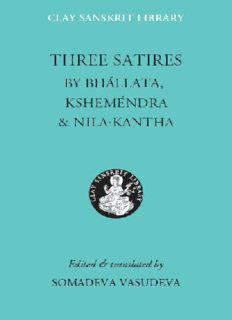Table Of ContentTHECLAYSANSKRITLIBRARY
FOUNDEDBYJOHN&JENNIFERCLAY
EDITEDBY
RICHARDGOMBRICH
WWW.CLAYSANSKRITLIBRARY.COM
WWW.NYUPRESS.ORG
Copyright(cid:2)c 2005bytheCSL.
Allrightsreserved.
FirstEdition2005.
TheClaySanskritLibraryisco-publishedby
NewYorkUniversityPress
andtheJJCFoundation.
Furtherinformationaboutthisvolume
andtherestoftheClaySanskritLibrary
isavailableonthefollowingwebsites:
www.claysanskritlibrary.com
www.nyupress.org
ISBN0-8147-8814-9
ArtworkbyRobertBeer.
CoverdesignbyIsabelleOnians.
Layout&typesetttingbySomadevaVasudeva.
PrintedinGreatBritainbyStEdmundsburyPressLtd,
BuryStEdmunds,Suffolk,onacid-freepaper.
BoundbyHunter&Foulis,Edinburgh,Scotland.
three satires
N¯ılakantha, Ksemendra
. . .
& Bhallata
.
EDITEDANDTRANSLATEDBY
SOMADEVA VASUDEVA
NEW YORK UNIVERSITY PRESS
JJC FOUNDATION
2005
LibraryofCongressCataloging-in-PublicationData
N¯ılakan.t.haD¯ıks.ita,17thcent.
[Kalivid.ambana.English&Sanskrit]
Threesatires/Nilakantha,Ksemendra&Bhallata;
editedandtranslatedbySomadevaVasudeva.
p.cm.–(TheClaySanskritlibrary)
InEnglishandSanskrit;includestranslationsfromSanskrit.
Includesbibliographicalreferencesandindex.
ISBN0-8147-8814-9(cloth:alk.paper)
I.Title:3satires.II.Vasudeva,Somadeva.
III.Ks.emendra,11thcent.Kala¯vila¯sa.English&Sanskrit.
IV.Bhallat.a,9thcent.Bhallat.a´sataka.English&Sanskrit.
V.Title.VI.Series.
PK3798.N54K3132005
891’.23–dc222004029512
Contents
7
Sanskritalphabeticalorder
7
CSLconventions
THREESATIRES
13
Introduction
1.Bha´llata:TheHundredAllegories 27
2.Ksheme´ndra:TheGraceofGuile 92
3.Nila·kantha:MockeryoftheKaliEra 319
341
Notes
378
Bibliography
383
Index
Asandhigridisprintedontheinsideofthebackcover
sanskritalphabeticalorder
Vowels: aa¯i¯ıuu¯.r.¯r.l.¯leaioaum. h.
Gutturals: kkhgghn˙
Palatals: cchjjhn˜
Retroflex: .t.thd. d.hn.
Labials: pphbbhm
Semivowels: yrlv
Spirants: ´s.ssh
guidetosanskritpronunciation
a but k luck
a¯,aˆ rather kh blockhead
i sit g go
¯ı,ˆı fee gh bighead
u put n˙ anger
u¯,uˆ boo c chill
.r vocalicr,Americanpurdy ch matchhead
orEnglishpretty j jog
.¯r lengthened.r jh aspiratedj,hedgehog
.l vocalicl,able n˜ canyon
e,ˆe,¯e made,esp.inWelshpro- .t retroflex t, try (with the
nunciation tip of tongue turned up
ai bite totouchthehardpalate)
o,oˆ,o¯rope,esp.Welshpronun- .th sameastheprecedingbut
ciation;Italiansolo aspirated
au sound d. retroflex d (with the tip
m. anusva¯ranasalizesthepre- of tongue turned up to
cedingvowel touchthehardpalate)
h. visarga,avoicelessaspira- d.h sameastheprecedingbut
tion(resemblingEnglish aspirated
h),orlikeScottishloch,or n. retroflex n (with the tip
anaspirationwithafaint of tongue turned up to
echoingofthepreceding touchthehardpalate)
vowelsothattaih. ispro- t Frenchtout
nouncedtaihi th tenthook
7
thethreesatires
d dinner r trilled,resemblingtheIta-
dh guildhall lianpronunciationofr
n now l linger
v word
p pill
´s shore
ph upheaval .s retroflexsh(withthetip
b before
ofthetongueturnedup
bh abhorrent totouchthehardpalate)
m mind s hiss
y yes h hood
cslpunctuationofenglish
TheacuteaccentonSanskritwordswhentheyoccuroutsideofthe
Sanskrittextitself,marksstress,e.g.Rama´yana.Itisnotpartoftra-
ditionalSanskritorthography,transliterationortranscription,butwe
supplyitheretoguidereadersinthepronunciationoftheseunfamiliar
words.SincenoSanskritwordisaccentedonthelastsyllableitisnot
necessarytoaccentdisyllables,e.g.Rama.
ThesecondCSLinnovationdesignedtoassistthereaderinthepro-
nunciationoflengthyunfamiliarwordsistoinsertanunobtrusivemid-
dledotbetweensemanticwordbreaksincompoundnames(provided
thewordbreakdoesnotfallonavowelresultingfromthefusionof
twovowels),e.g.Maha·bha´rata,butRama´yana(notRama·a´yana).Our
dotechoesthepunctuatingmiddledot(·)foundintheoldestsurviv-
ingsamplesofwrittenSanskrit,theAshokaninscriptionsofthethird
centurybce.
ThedeeplayeringofSanskritnarrativehasalsodictatedthatweuse
quotationmarksonlytoannouncethebeginningandendofeverydirect
speech,andnotatthebeginningofeveryparagraph.
cslpunctuationofsanskrit
TheSanskrittextisalsopunctuated,inaccordancewiththepunc-
tuationoftheEnglishtranslation.Inmid-verse,thepunctuationwill
notalterthesandhiorthescansion.Propernamesarecapitalized,asare
theinitialwordsofverses(orparagraphsinprosetexts).MostSanskrit
8
cslconventions
metreshavefour“feet”(pa¯da):wherepossibleweprintthecommon
´slokametreontwolines.Thecapitalizationofversebeginningsmakes
iteasyforthereadertorecognizelongermetreswhereitisnecessaryto
printthefourmetricalfeetoverfouroreightlines.IntheSanskrittext,
we use French Guillemets (e.g. «kva sam.cic¯ır.suh.?») instead of English
quotationmarks(e.g.“Whereareyouoffto?”)toavoidconfusionwith
theapostrophesusedforvowelelisioninsandhi.
Sanskritpresentsthelearnerwithachallenge:sandhi(“euphoniccom-
bination”).Sandhimeansthatwhentwowordsarejoinedinconnected
speechorwriting(whichinSanskritreflectsspeech),thelastletter(or
evenletters)ofthefirstwordoftenchanges;comparethewaywepro-
nounce“the”in“thebeginning”and“theend.”
InSanskritthefirstletterofthesecondwordmayalsochange;andif
boththelastletterofthefirstwordandthefirstletterofthesecondare
vowels,theymayfuse.ThishasaparallelinEnglish:anasalconsonantis
insertedbetweentwovowelsthatwouldotherwisecoalesce:“apear”and
“anapple.”Sanskritvowelfusionmayproduceambiguity.Thechartat
thebackofeachbookgivesthefullsandhisystem.
Fortunatelyitisnotnecessarytoknowthesechangesinordertostart
readingSanskrit.Forthat,whatisimportantistoknowtheformofthe
secondwordwithoutsandhi(pre-sandhi),sothatitcanberecognized
orlookedupinadictionary.ThereforeweareprintingSanskritwitha
systemofpunctuationthatwillindicate,unambiguously,theoriginal
formofthesecondword,i.e.,theformwithoutsandhi.Suchsandhi
mostlyconcernsthefusionoftwovowels.
InSanskrit,vowelsmaybeshortorlongandarewrittendifferently
accordingly. We follow the general convention that a vowel with no
markaboveitisshort.Otherbooksmarkalongvoweleitherwitha
barcalledamacron(a¯)orwithacircumflex(aˆ).Oursystemusesthe
macron, except that for initial vowels in sandhi we use a circumflex
toindicatethatoriginallythevowelwasshort,ortheshorteroftwo
possibilities(eratherthanai,oratherthanau).
Whenweprintinitialaˆ,beforesandhithatvowelwasa
ˆıorˆe, i
uˆoroˆ, u
aˆi, e
9
Description:The Dark Age Ridiculed, by Níla·kantha, Beguiling Artistry, by Ksheméndra, The Hundred Allegories, by BhállataWritten over a period of nearly a thousand years, these works show three very different approaches to satire. Níla·kantha gets straight to the point: swindlers prey on stupidity.The ar

